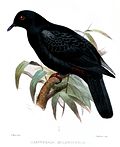| Section | Image | Scientific name | Distribution |
|---|
| Poliocephala species-group |  | Ducula poliocephala (Gray, 1844) pink-bellied imperial pigeon | Philippines. |
|---|
 | Ducula forsteni (Bonaparte, 1854) white-bellied imperial pigeon | Indonesia (Sulawesi, Buton, Taliabu, Togian, and Peleng.) |
 | Ducula mindorensis (Whitehead, 1896) Mindoro imperial pigeon | Philippines (Mindoro) |
| Ducula radiata (Quoy & Gaimard, 1830) Grey-headed imperial pigeon | Indonesia (Sulawesi) |
| Carola species-group |  | Ducula carola (Gray, 1844) Spotted imperial pigeon | Philippines |
|---|
| Aenea species-group |  | Ducula aenea (Linnaeus, 1766) Green imperial pigeon | Nepal, southern India and Sri Lanka eastwards to southern China, Indonesia and the Philippines. |
|---|
| Ducula oenothorax (Salvadori, 1892) Enggano imperial pigeon | Enggano Island. |
| Ducula nicobarica (Pelzeln, 1865) Nicobar imperial pigeon | Nicobar Islands. |
 | Ducula perspicillata (Temminck, 1824) Spectacled imperial pigeon | Maluku Islands. |
 | Ducula neglecta (Schlegel, 1866) Seram imperial pigeon | Moluccas |
 | Ducula concinna (Wallace, 1865) Elegant imperial pigeon | New Guinea, Talaud Islands, Sangihe, islands off southern Sulawesi, the southern Maluku Islands, and the eastern Lesser Sundas from Romang to Tanimbar, east up to the Aru Islands. |
 | Ducula pacifica (Gmelin, 1789) Pacific imperial pigeon | American Samoa, the Cook Islands, Fiji, Kiribati, Niue, Papua New Guinea, Samoa, Solomon Islands, Tokelau, Tonga, Tuvalu, Vanuatu, and Wallis and Futuna Islands. |
 | Ducula oceanica (Desmarest, 1826) Micronesian imperial pigeon | Palau, the Caroline Islands, the Marshall Islands and Nauru. |
 | Ducula aurorae (Peale, 1848) Polynesian imperial pigeon | French Polynesia. |
 | Ducula galeata (Bonaparte, 1855) Marquesan imperial pigeon | Nuku Hiva in the Marquesas Islands of French Polynesia. |
 | Ducula rubricera (Bonaparte, 1854) Red-knobbed imperial pigeon | Bismarck Archipelago and the Solomon Islands archipelago. |
 | Ducula myristicivora (Scopoli, 1786) Spice imperial pigeon | Indonesia |
| Ducula geelvinkiana Schlegel, 1873 Geelvink imperial pigeon [11] | Indonesia's Schouten Islands |
 | Ducula rufigaster (Quoy & Gaimard, 1830) Purple-tailed imperial pigeon | New Guinea. |
 | Ducula basilica Bonaparte, 1854 Cinnamon-bellied imperial pigeon | Moluccas. |
 | Ducula finschii (Ramsay, 1882) Finsch's imperial pigeon | Papua New Guinea. |
| Ducula chalconota (Salvadori, 1874) Rufescent imperial pigeon | New Guinea. |
 | Ducula pistrinaria Bonaparte, 1855 Island imperial pigeon | Bismarck Archipelago and the Solomon Islands archipelago |
 | Ducula rosacea (Temminck, 1835) Pink-headed imperial pigeon | Lesser Sunda Islands of Indonesia |
 | Ducula whartoni (Sharpe, 1887) Christmas imperial pigeon | Christmas Island |
 | Ducula pickeringii (Cassin, 1854) Grey imperial pigeon | Sulu Archipelago, Miangas and Talaud Islands |
|  | Ducula latrans (Peale, 1848) Barking imperial pigeon | Fiji |
|---|
| Brenchleyi species-group | | Ducula brenchleyi (Gray, 1870) Chestnut-bellied imperial pigeon | Solomon Islands. |
|---|
| Ducula bakeri (Kinnear, 1928) Vanuatu imperial pigeon | Vanuatu |
 | Ducula goliath (Gray, 1859) Goliath imperial pigeon | New Caledonia. |
 | Ducula pinon (Quoy & Gaimard, 1824) Pinon's imperial pigeon | New Guinea. |
 | Ducula melanochroa (Sclater, 1878) Black imperial pigeon | Bismarck Archipelago |
 | Ducula mullerii (Temminck, 1835) Collared imperial pigeon | New Guinea |
| Zoe's imperial pigeon |  | Ducula zoeae (Lesson, 1826) Zoe's imperial pigeon | New Guinea. |
|---|
| Badia species group |  | Ducula cuprea (Jerdon, 1840) Malabar imperial pigeon | Western Ghats of India. |
|---|
 | Ducula badia (Raffles, 1822) Mountain imperial pigeon | Bangladesh, Bhutan, Brunei, Cambodia, China, India, Indonesia, Laos, Malaysia, Myanmar, Nepal, Thailand, and Vietnam |
 | Ducula lacernulata (Temminck, 1823) Dark-backed imperial pigeon | Lesser Sunda Islands. |
 | Ducula cineracea (Temminck, 1835) Timor imperial pigeon | Timor and Wetar. |
| Bicolor species-group |  | Ducula bicolor (Scopoli, 1786) Pied imperial pigeon | Myanmar and Thailand, throughout Indonesia and east to the Philippines and the Bird's Head Peninsula in New Guinea. |
|---|
 | Ducula luctuosa (Temminck, 1825) Silver-tipped imperial pigeon | Sulawesi |
 | Ducula spilorrhoa (Gray, 1858) Torresian imperial pigeon | Australia (north-east Western Australia, north Northern Territory and north Queensland, including the Torres Strait Islands), New Guinea, Aru Islands, islands in the Geelvink Bay, D'Entrecasteaux Islands and Louisiade Archipelago. |
 | Ducula subflavescens (Finsch, 1886) Yellowish imperial pigeon | Bismarck Archipelago. |
|





































